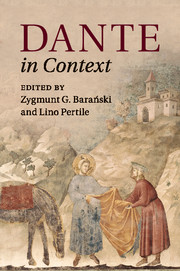Book contents
- Frontmatter
- Dedication
- Contents
- List of illustrations
- List of maps
- Notes on contributors
- Chronology
- Abbreviations and note on translations
- Introduction
- Part I Politics and society
- Part II Intellectual traditions
- Part III Linguistic and literary cultures
- 15 Linguistic Italy
- 16 Education
- 17 Rhetoric, literary theory, and practical criticism
- 18 Classical antiquity
- 19 Religious culture
- 20 Visions and journeys
- 21 Historical and political writing
- 22 Vernacular literatures
- 23 Popular culture
- Part IV Visual and performative culture
- Part V Dante: life, works, and reception
- Further reading
- Index
18 - Classical antiquity
from Part III - Linguistic and literary cultures
Published online by Cambridge University Press: 05 October 2015
- Frontmatter
- Dedication
- Contents
- List of illustrations
- List of maps
- Notes on contributors
- Chronology
- Abbreviations and note on translations
- Introduction
- Part I Politics and society
- Part II Intellectual traditions
- Part III Linguistic and literary cultures
- 15 Linguistic Italy
- 16 Education
- 17 Rhetoric, literary theory, and practical criticism
- 18 Classical antiquity
- 19 Religious culture
- 20 Visions and journeys
- 21 Historical and political writing
- 22 Vernacular literatures
- 23 Popular culture
- Part IV Visual and performative culture
- Part V Dante: life, works, and reception
- Further reading
- Index
Summary
The heritage of classical antiquity and in particular the status of the great Latin authors vacillated throughout the centuries, both during and since ancient times themselves: not only did particular authors rise and fall in favour, but there were even periods when the very study of the great classics went into eclipse. Interest in the Latin classics and particularly the study of the ancient Latin authors dwindled in Italy during the sixth, seventh, and eighth centuries, and it was mainly in the ninth century that a significant revival of the ancient literary curriculum based on a study of classical authors was launched.
The apogee of classical studies in medieval Italy was reached in the twelfth century. According to Otto of Freising (c.1114–58), the Lombards in the first half of the twelfth century retained ‘the elegance of the Latin language’, and Roffredo da Benevento (c.1170–c.1243) referred to the flourishing state of Latin literary study in Arezzo at the turn of the thirteenth century. A striking literary text written in twelfth-century Italy is Henry of Settimello's (fl. c.1190) famous Elegy, the most significant piece of classicizing Latin poetry composed in Italy before Lovato Lovati (1241–1309) and the emergence of Paduan humanism. It shows the direct influence of Ovid's poetry of exile and echoes of Virgil and Horace are evident; there are numerous references to the classical world, while biblical allusions are rare, and Henry's Stoic philosophy was possibly stimulated by Seneca. Henry was drawn to the classicizing French Latin poets of the twelfth century, such as Walter of Châtillon (1135–1204), Alan of Lille (1116–1202), and Matthew of Vendôme (second half of twelfth century), whose verse techniques and stylistic eccentricities he appropriated.
The clearest direct evidence of the trend is the survival of classical Latin authors used as schoolbooks. In a survey published in 2001, it was possible to identify forty-one Italian manuscript texts of classical authors used as schoolbooks and produced in Italy during the twelfth century and now housed in Florentine libraries, but of course they do not all originate from Florence or even Tuscany. The strong presence of Latin classical authors in twelfth-century Italy, as revealed by the Florentine census, was further confirmed by a continuing survey outside Florence. In 2006 a subsequent publication identified 127 Italian-copied manuscripts of classical Latin authors produced or used as schoolbooks in twelfth-century Italy and now housed outside Florence.
Information
- Type
- Chapter
- Information
- Dante in Context , pp. 297 - 318Publisher: Cambridge University PressPrint publication year: 2015
Accessibility standard: Unknown
Why this information is here
This section outlines the accessibility features of this content - including support for screen readers, full keyboard navigation and high-contrast display options. This may not be relevant for you.Accessibility Information
- 2
- Cited by
